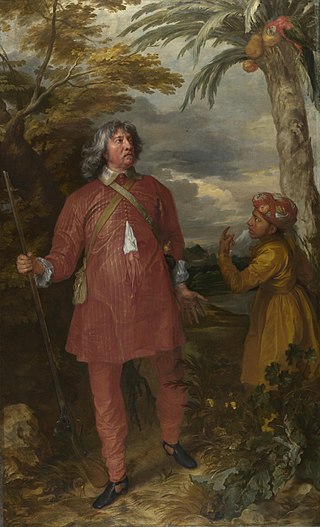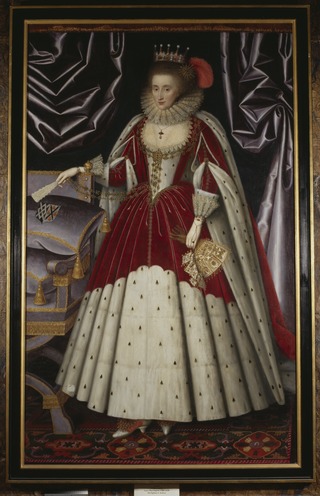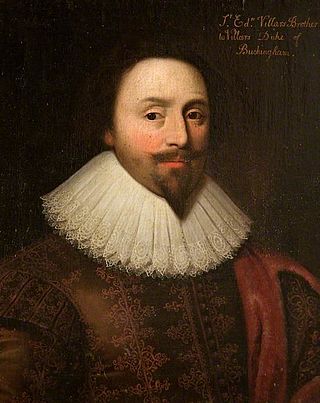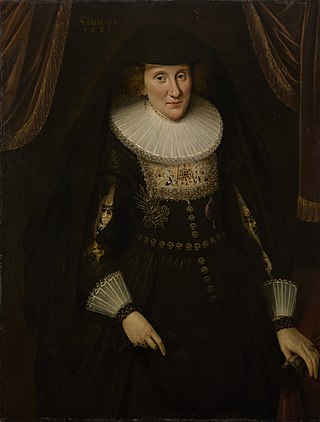Related Research Articles

Anne of Denmark was the wife of King James VI and I. She was Queen of Scotland from their marriage on 20 August 1589 and Queen of England and Ireland from the union of the Scottish and English crowns on 24 March 1603 until her death in 1619.

Henry Cary, 1st Viscount Falkland, KB, PC was an English landowner and politician who sat in the House of Commons from 1601 to 1622. He was created Viscount Falkland in the Scottish peerage in 1620. He was Lord Deputy of Ireland from 1622 until 1629.

William Feilding, 1st Earl of Denbigh was an English courtier. As brother-in-law of the royal favourite, the Duke of Buckingham, he became involved in major political, military and diplomatic events during the latter part of the reign of James I and under Charles I.

Katherine Howard, Countess of Suffolk was an English court office holder who served as lady-in-waiting to the queen consort of England, Anne of Denmark.
Sir George Carew was an English diplomat, historian and Member of Parliament.
A maid of honour is a junior attendant of a queen in royal households. The position was and is junior to the lady-in-waiting. The equivalent title and office has historically been used in most European royal courts.

The Masque of Blackness was an early Jacobean era masque, first performed at the Stuart Court in the Banqueting Hall of Whitehall Palace on Twelfth Night, 6 January 1605. It was written by Ben Jonson at the request of Anne of Denmark, the queen consort of King James I, who wished the masquers to be disguised as Africans. Anne was one of the performers in the masque along with her court ladies, all of whom appeared in blackface makeup. In a ceremony earlier on the day, Prince Charles, Anne's second son was given the title of Duke of York.

Lucy Russell, Countess of Bedford was a major aristocratic patron of the arts and literature in the Elizabethan and Jacobean eras, the primary non-royal performer in contemporary court masques, a letter-writer, and a poet. She was an adventurer (shareholder) in the Somers Isles Company, investing in Bermuda, where Harrington Sound is named after her.
The Shepherd's Paradise was a Caroline era masque, written by Walter Montagu and designed by Inigo Jones. Acted in 1633 by Queen Henrietta Maria and her ladies in waiting, it was noteworthy as the first masque in which the Queen and her ladies filled speaking roles. Along with Tempe Restored (1632), The Shepherd's Paradise marked a step in the evolution in attitudes and practices that led to the acceptance of women onstage during the coming Restoration era.

Sir Edward Villiers was an English nobleman from Leicestershire and member of the Villiers family, whose younger half-brother George Villiers, 1st Duke of Buckingham, was a favourite of both James VI and I and his son Charles. Through his influence, Sir Edward gained various positions, including Master of the Mint, Member of Parliament for Westminster and Lord President of Munster. He died in Ireland in September 1626.
The Honourable Walter Stewart was a Scottish courtier, physician, and politician who sat in the House of Commons from 1624 to 1625. He was the father of Frances Stewart, Duchess of Richmond, otherwise known as "La Belle Stuart".
Lady Audrey Walsingham was an English courtier. She served as Lady of the Bedchamber to queen Elizabeth I of England, and then as Mistress of the Robes to Anne of Denmark from 1603 until 1619.
Sir Ambrose Turvile, (1581-1628), Courtier and cupbearer to Anne of Denmark.
Bridget Annesley was a courtier to Anne of Denmark, wife of James VI and I.
Mary Woodhouse, Lady Killigrew, musician and correspondent of Constantijn Huygens, was the daughter of Henry Woodhouse (MP) of Hickling and Waxham, and Anne Bacon, daughter of Sir Nicholas Bacon. She may have been the "Woodhouse" appointed Maid of Honour to Anne of Denmark in December 1603.

Cecilia Crofts, courtier and maid of honour to Henrietta Maria, subject of poems.
George Kirke was a Scottish-born courtier and Member of Parliament for Clitheroe.

Anne Killigrew was a Lady in Waiting to Queen Henrietta Maria, and the first wife of George Kirke who was Groom of the Chamber to Charles I of England.

Anna Hay, Countess of Winton (1592-1628) was a Scottish courtier.
Mother of the Maids was a position at the English royal court. The Mother of the Maids was responsible for the well-being and decorum of maids of honour, young gentlewomen in the household of a queen regnant or queen consort.
References
- ↑ Sarah Poynting, 'Henrietta Maria's Notorious Whores', Clare McManus, Women and Culture at the Courts of the Stuart Queens (Palgrave Macmillan, 2003), p. 167.
- ↑ Henry Ellis, Original Letters, 1st Series vol. 3 (London, 1824), p. 82.
- ↑ James Morrin, Calendar of the Patent and Close Rolls of Chancery in Ireland (London, 1863), pp. 654-5.
- ↑ Jemma Field, 'The Wardrobe Goods of Anna of Denmark', Costume, 51:1 (March 2017), on-line supplement, p. 42 no. 347, 53 no. 452.
- ↑ John Nichols, Progresses of Anne of Denmark, vol. 3 (London, 1828), p. 541.
- ↑ E. K. Purnell & A. B. Hinds, HMC Downshire, vol. 2 (London, 1936), p. 308
- ↑ Norman Egbert McClure, Letters of John Chamberlain, vol. 2 (Philadelphia, 1939), p. 599.
- ↑ 'Carew, Francis I (c.1598-1628), of Westminster', History of Parliament: the House of Commons 1604-1629, ed. Andrew Thrush and John P. Ferris, 2010
- ↑ Sarah Poynting, 'Henrietta Maria's Notorious Whores', Clare McManus, Women and Culture at the Courts of the Stuart Queens (Palgrave Macmillan, 2003), pp. 163, 168.
- ↑ Mary Anne Everett Green, Calendar State Papers Domestic, 1654 (London, 1886), p. 331.